ANGEL DAY CONTINUES ACROSS THE COUNTRY!


The post ANGEL DAY CONTINUES ACROSS THE COUNTRY! appeared first on Stand Up For Pits Foundation.
Dogster Photo Contest: Dogs of the Week Winners (October 25, 2024)
The post Dogster Photo Contest: Dogs of the Week Winners (October 25, 2024) by Dogster Team appeared first on Dogster. Copying over entire articles infringes on copyright laws. You may not be aware of it, but all of these articles were assigned, contracted and paid for, so they aren’t considered public domain. However, we appreciate that you like the article and would love it if you continued sharing just the first paragraph of an article, then linking out to the rest of the piece on Dogster.com.
Click to Skip Ahead
This Week’s Winner

| Name: | Koda |
| Breed: | Poodle Terrier Mix |
| Fun Fact: | Koda is a rescue dog with the most fabulous ears that give him the nickname of Koda the Canine Yoda. His parents’ goal in life is to give him as many unique experiences as they can. This photo was taken after Koda created his own artwork on canvas thanks to his love for peanut butter! They never knew that Koda was this talented! |

Silliest

| Name: | Harley |
| Breed: | Mixed Lab |
| Fun Fact: | 3yr old Lab/Great Pyrenees mix, tons of energy, and loves to lay on her back while playing with her toys |
- Check out our Doggos Weekly articles to see what the dogs of Dogster have been up to!

Cutest

| Name: | Luna |
| Breed: | Bernedoodle |
| Fun Fact: | She’s the cutest of the cute! |

Most Dignified

| Name: | Rowdy |
| Breed: | Great Pyrenees Mix |
| Fun Fact: | For Halloween, Rowdy is being a royal king, and he takes the role seriously. He’s very goofy, very Rowdy, but he can also be quite dignified and regal. Great Pyrenees were a favorite of French Royals like Dauphin Louis XIV and also Queen Victoria of England. |

Most Expressive
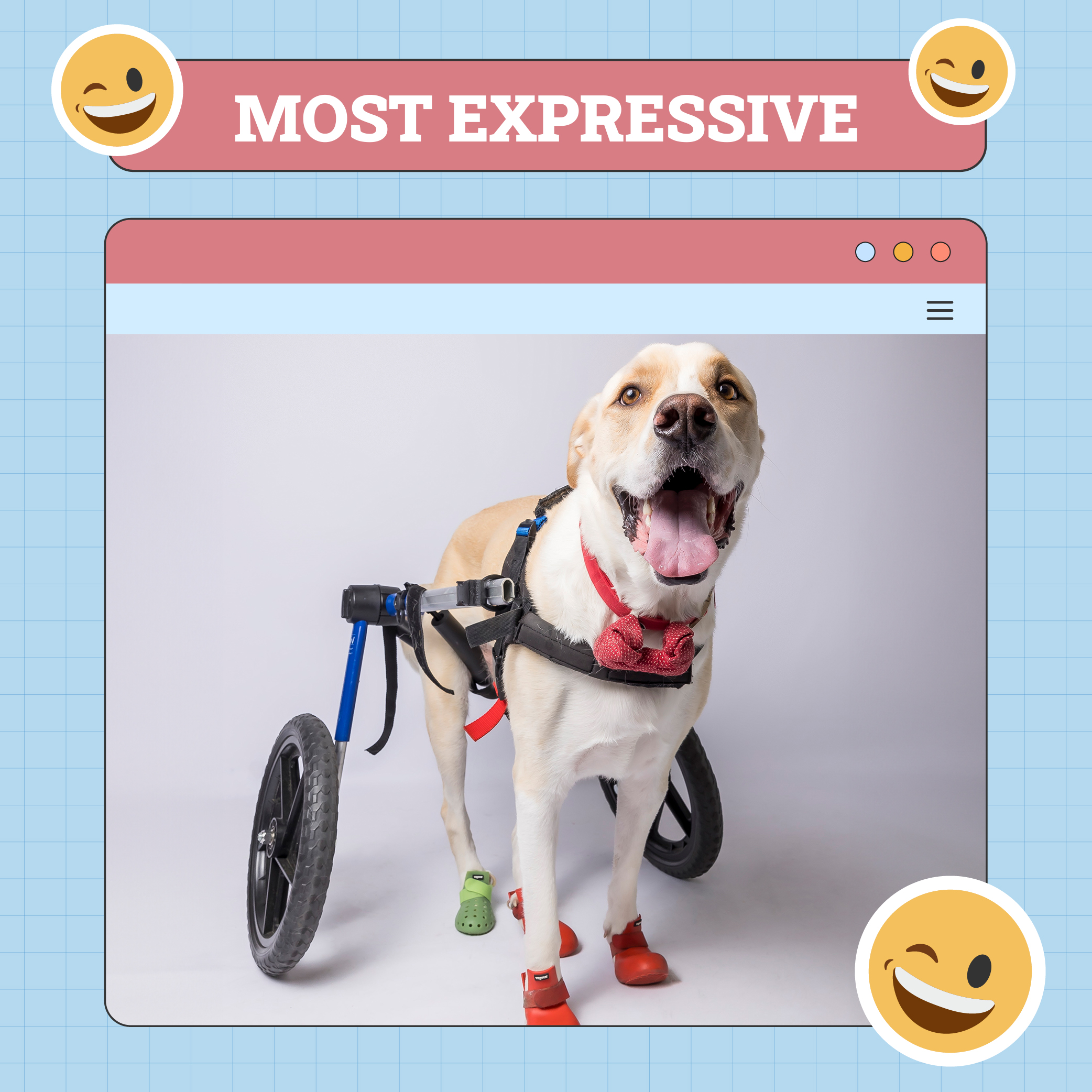
| Name: | Sammy |
| Breed: | Great Pyrenees |
| Fun Fact: | Sammy is a rescue dog who was abandoned to die as a puppy. He was born with birth defects that surgery could not correct, so he is living his best life in wheels and also is the emotional support dog to his human brother with dyslexia. |

Sleepiest

| Name: | Eddie |
| Breed: | Jack Russell Mix |
| Fun Fact: | Eddie is a rescue who was found at two weeks old with his siblings in a plastic bag. Thankfully, he was rescued and he was adopted at 12 weeks old. He hates the mornings, he loves to have a lay in, and he is hyper in the afternoon. He’s such a loyal dog, and his parents love him very much! |

Enter Your Dog
Submit your doggie for a chance to be featured! Click here
The post Dogster Photo Contest: Dogs of the Week Winners (October 25, 2024) by Dogster Team appeared first on Dogster. Copying over entire articles infringes on copyright laws. You may not be aware of it, but all of these articles were assigned, contracted and paid for, so they aren’t considered public domain. However, we appreciate that you like the article and would love it if you continued sharing just the first paragraph of an article, then linking out to the rest of the piece on Dogster.com.
Renting An Adventure Van With Pets
Road trips are a classic form of adventure. One of my favorite vacations growing up was our family road trip to Montana … probably because my yellow lab, Chica, was allowed to come along. Epic road trips are still my favorite way to travel with my dogs. If you agree, renting an adventure van with your pets might be a great option!
Renting An Adventure Van With Pets
An enjoyable road trip is about more than the destination. You also need the appropriate vehicle for your journey. Campervans are a great choice if you’re not up for tent or car camping, but can live without all the bells and whistles of a full-blown RV.
Most campervans are just a bit bigger than your average vehicle. So they’re still easy to drive and park, while offering space for gear and room to sleep. And the bonus? Many rental companies understand that family vacations means taking your pets along, so there are several pet friendly options!
READ MORE ⇒ Pet Friendly RV Rental Companies

Policies And Fees
As with any rental, each company has different policies and fees. Call to verify any information you find online and clarify the rules regarding your furry companion.

I rented from Escape Campervans in Phoenix, and though they had no restrictions on size or breed, pets were not allowed during July, August, and September. While this seasonal restriction is meant to protect pets from hot vehicles, it could affect your plans if you’re hoping to travel during summer vacation.
Questions for your campervan rental company:
- Are pets allowed in the van?
- Are there additional fees for bringing a pet along?
- Is there a pet weight limit or a breed restriction?
- How many pets are allowed in the van?
- Are there any additional rules pertaining to pets?
Safety During Travel
Once you’ve found a van that will accommodate your pets – it’s time to think about where they’ll ride while you’re driving.
Many campervans have a back seat that converts to a bed, so your pets might be able to ride just like they do in your regular vehicle. There are seat belts available to use with safety harnesses, and there might be space on the floor where a kennel would fit. When in doubt, ask the rental company – they might have additional suggestions.
READ MORE ⇒ Best Crash-Tested Dog Harnesses For The Car

Our adventure van, Hawaii, was fantastic! But the back seat was a little narrow for CW and Herc to share. Luckily, the seatbelts were accessible in the bed configuration, so I was able to keep the dogs secure without worrying that they’d slip off the seat.
Also, if your dog has a valid driver’s license and can reach the pedals, the driver’s seat is a potential option. Just kidding — Herc likes to scout for squirrels while CW and I nap!

What To Pack
Plan to bring what you’d normally take for a trip with your pets: food, water, bowls, leashes, harnesses, treats, and toys. Then add in any additional weather or terrain requirements: warm layers, raincoats, paw protection, outdoor beds, and towels for dirty paws.
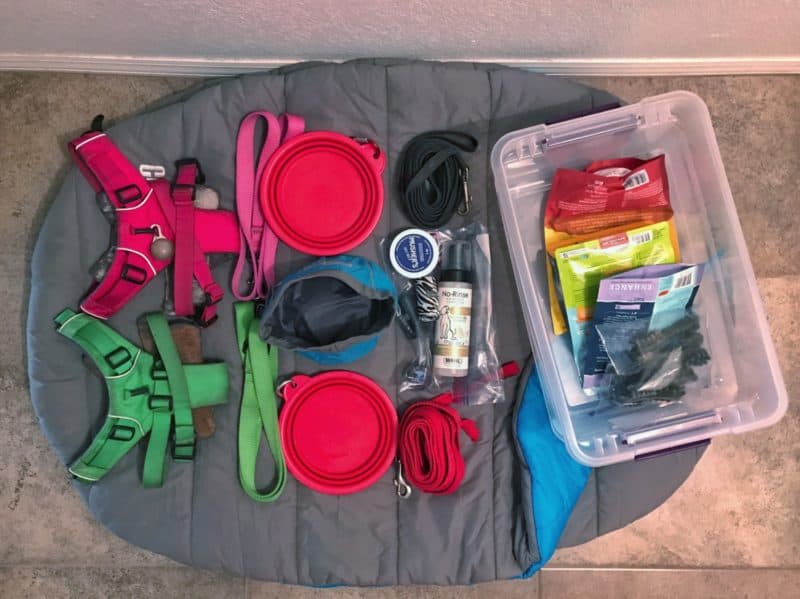
Also bring plenty of cleaning supplies: paper towels, cleaning wipes, fabric freshener, etc. It’s Murphy’s Law that if your dog gets sick in the vehicle it will be when you’re in the middle of nowhere with no access to running water or a washing machine. Trust me on this one! Also, pick up some dry shampoo for pets. No one wants to be stuck with a smelly dog — especially in a small space.
Finally, outdoor beds and an old yoga mat made life infinitely easier. A small space can get dirty quickly, so clean dogs means a clean(er) van! The dog beds provided comfy seating where the pups could supervising my cooking. And the yoga mat made a handy doormat to wipe paws and keep dirt out of the van. Yoga mats are easy to clean and roll up nicely for storage. Plus they’re super-helpful for finding your zen after any less-than-stellar moments!
READ MORE ⇒ Camping With Dogs – A Beginner’s Guide

Where To Park?
There are many, many places to take an adventure van and park for the night. You can go to state park campgrounds, private campgrounds, national parks, national forests, and Army Corp of Engineers campgrounds. You can also explore dispersed camping at Bureau of Land Management (BLM) locations.
Where you park really depends on what you find enjoyable and the amenities you want. Most state park, national park, ACE, and private campgrounds offer hot showers, flush toilets, and a campsite with a picnic table. Private campgrounds generally have additional amenities like internet, laundry facilities, and a camp store. National forest campgrounds usually have pit toilets and a picnic table at your site, but no showers. And BLM and other disbursed campsites might have a fire ring, but that will be about it. You can find listings for thousands of pet friendly campgrounds at GoPetFriendly.com.
READ MORE ⇒ RV Parks Or Boondocking?
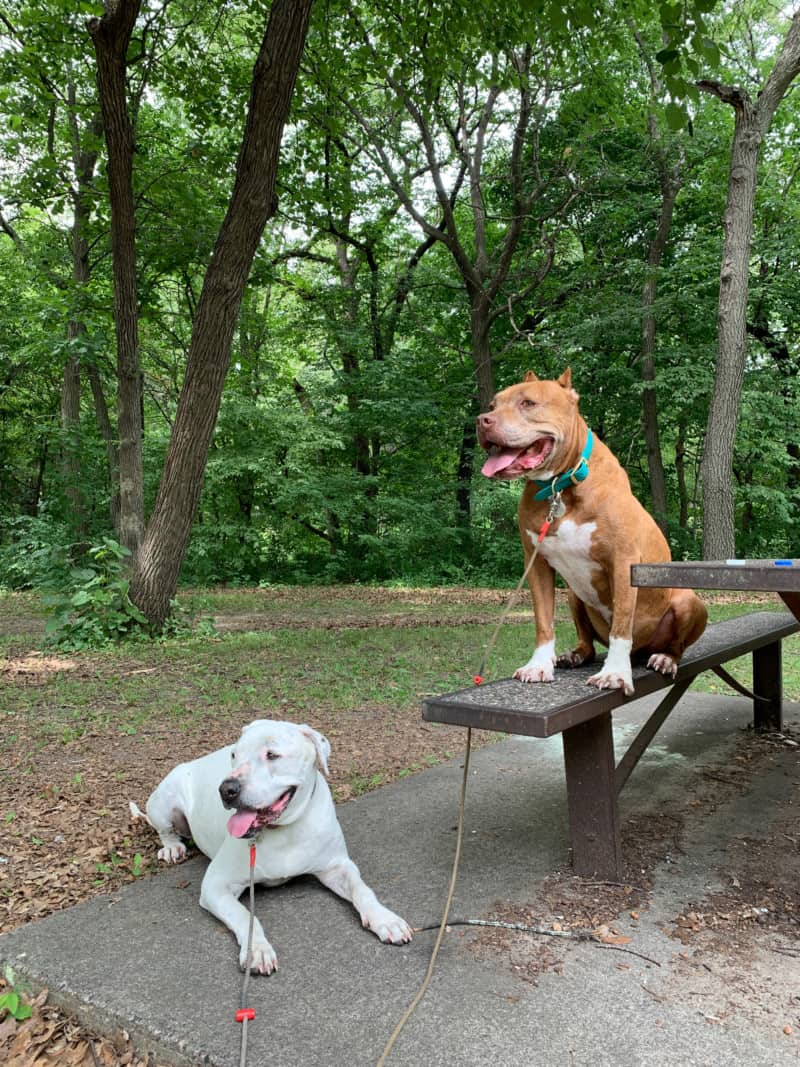
Tips And Tricks
Review the list of gear that comes with your van rental before you start packing. Some things you’d normally take might already be included.
The van we rented came with camp chairs, bedding (fitted sheet, comforter, and 2 pillows), and basic kitchenware (propane stove, 2 pots, 1 pan, 3 dining sets, and several other miscellaneous utensils). I brought another pillow and a few blankets so Cool Whip and Herc had familiar items to calm them at bedtime.
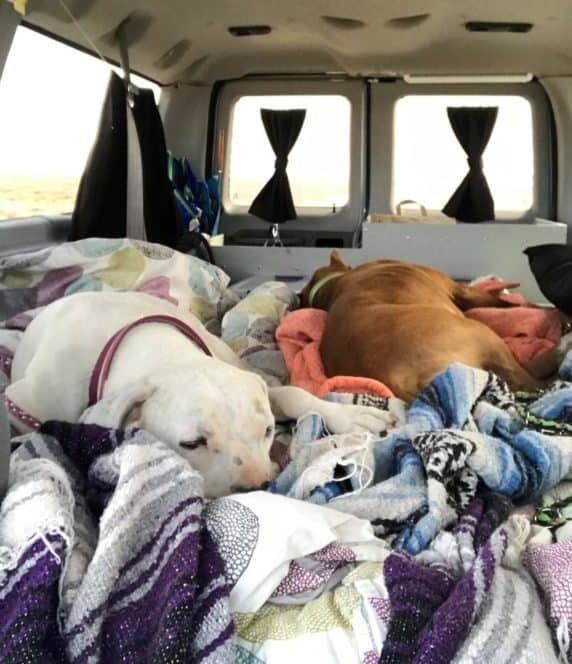
Storage is where you’ll want to get creative. Plastic storage containers are great for keeping gear secure, organized, and easy to move around. And in the evening you can easily shift the containers to the front seats for more sleeping space.
I like 15-quart sized containers; they hold a decent amount without getting too bulky. Our van had two built-in storage boxes, space underneath the bed, and a shelving unit in the kitchen area for stowing our gear.
At meal time, always be on the lookout for food thieves lurking in the background. They’ll patiently wait for you to forget about that plate of pancakes on the counter!

With those tips, we hope you’re soon renting an adventure van with your pets and making your own pawsome memories! If you get really ambitious, check out our blog post highlighting the most pet friendly sites along Historic Route 66!
DO MORE ⇒ Route 66 – Pet Friendly Sights From Chicago to Santa Monica
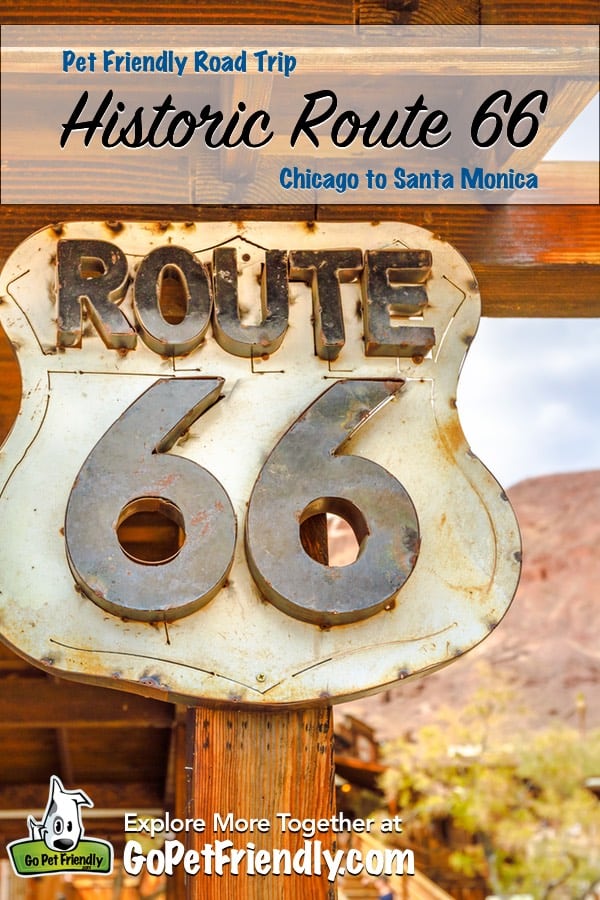
The post Renting An Adventure Van With Pets appeared first on GoPetFriendly.com.
Silipint Silicone Aqua-Fur Dog Bowl Review 2024: An Expert’s Breakdown
The post Silipint Silicone Aqua-Fur Dog Bowl Review 2024: An Expert’s Breakdown by Gabrielle McGhee appeared first on Dogster. Copying over entire articles infringes on copyright laws. You may not be aware of it, but all of these articles were assigned, contracted and paid for, so they aren’t considered public domain. However, we appreciate that you like the article and would love it if you continued sharing just the first paragraph of an article, then linking out to the rest of the piece on Dogster.com.
Click to Skip Ahead
We give Silipint’s Aqua-Fur Dog Bowl a rating of 4.75 out of 5 stars.
If you enjoy taking your dog on road trips with you, then you know what a commodity space is when it comes to packing their belongings. In our family, our three dogs have their own travel bags, which can take up quite a bit of room in our vehicle. This means we all must pack as light as possible, but whether your dog is accompanying you on a day trip or an extended overnight stay, one thing you can’t do without is a dog bowl. That’s where soft foldable pet bowls come in handy. These can be made from a variety of flexible materials, and one of the safest and most durable options is silicone.
The Silipint company in Bend, Oregon is one such brand manufacturing dog bowls, human drinking cups, and other food containers out of silicone. But why silicone? Well, the answer is simple – silicone is readily available, non-toxic, and durable. And when it comes to dog bowls, it can also be used to create a foldable product that is easy to transport. Though Silipint is better known today for their creatively designed drinking tumblers, this company got its start making dog leashes and bowls over 15 years ago. Their foldable dog bowls are still a popular product today, and a great item to travel with when you decide to take your pup along. Whether you’re looking to save space on a long car ride with your dog, or you need something lightweight to carry in your backpack when you go hiking, the Aqua-Fur foldable silicone dog bowl from Silipint fits the bill. It is also incredibly durable and easy to clean, making it a fantastic product to keep in your pet supplies arsenal for years to come.

About the Silipint
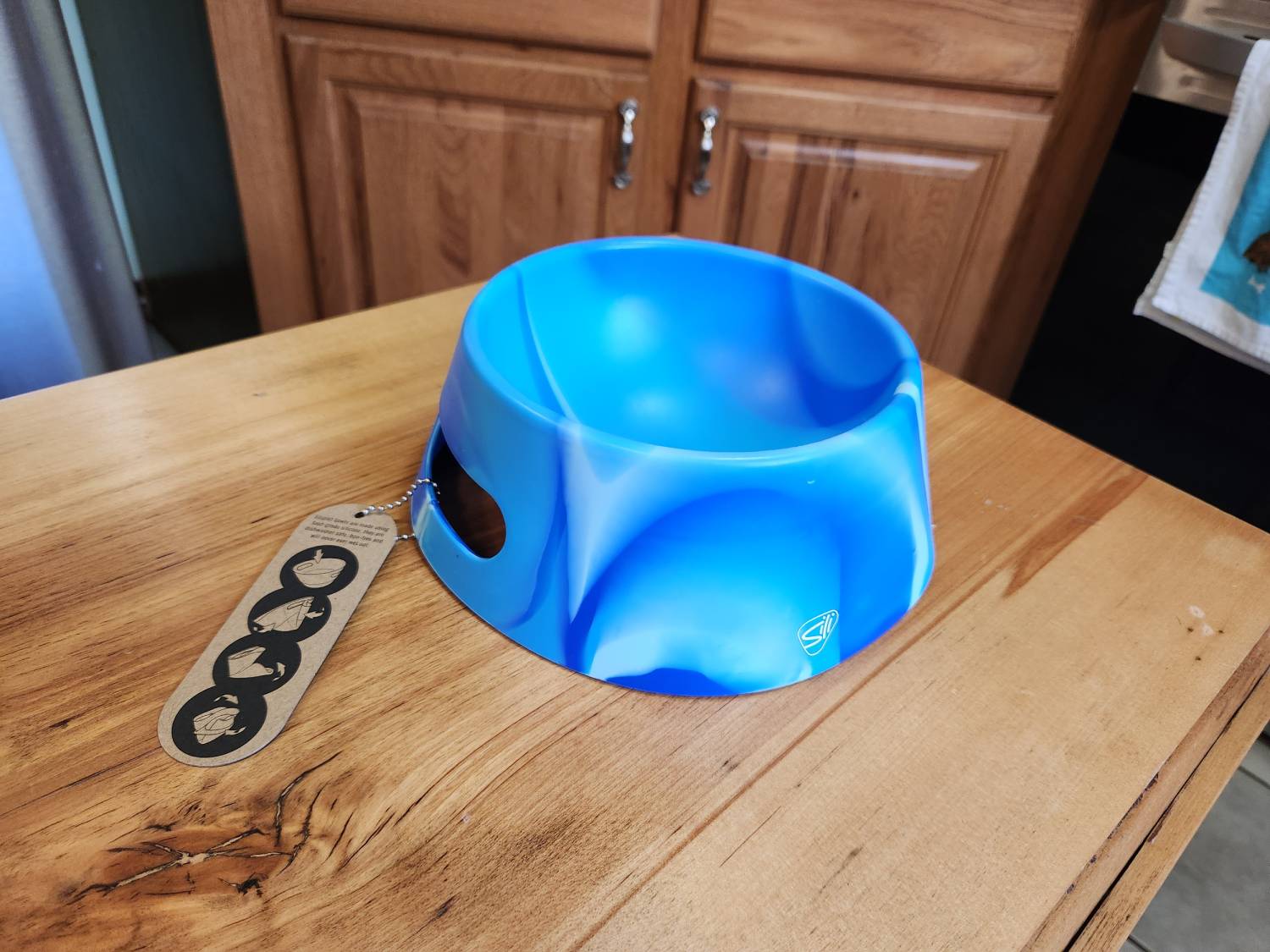
Almost two decades ago, outdoor enthusiast and dog lover Rick Fredland started his innovative brand, Tazlab. His initial design was a safer dog collar made of silicone with the primary goal of preventing accidental strangulations, but he also came up with a multifunctional silicone leash, as well as a foldable silicone dog bowl. It wasn’t until he started promoting his pet products at trade shows that he got the idea to start making silicone pint “glasses” so the show patrons could be served frosty beverages at his booth. He quickly realized this was an untapped market, and soon switched gears to create his current business, Silipint, with a mission to help people live a more sustainable life through products that deliver joy.
Silipint, founded in 2010, is now a successful supplier of many silicone items, including their original foldable dog bowls. The company utilizes non-toxic silica, a naturally occurring component of sand, to derive rubber-like silicone which is both lightweight and flexible. This material is used to produce the Aqua-Fur Dog Bowl and has many benefits. It is eco-friendly, resistant to tears and leaks, and easy to clean. It is also dishwasher, microwave, and freezer safe. But the best feature is its foldability! With a little practice, any dog owner can quickly fold and secure this bowl into a compact shape that is small enough to tuck away in a backpack or even a large pants pocket. Anybody who enjoys traveling with their dog or taking their pup on outdoor excursions will enjoy the convenience of including the Aqua-Fur Dog Bowl in their gear.

Aqua-Fur Dog Bowl Overview

Here is an overview of Silipint’s Aqua-Fur Dog Bowl. This lightweight foldable bowl is a great option for pet parents on the go, and won’t leak, tear, or weigh you down on the trail. It is safe for your dog and the environment and lasts for years.
Quality
The Aqua-Fur Dog Bowl is a quality piece of pet equipment designed to stand up to squished car rides, boisterous pups, and difficult hikes. It is sturdy enough to maintain its shape, thus preventing leaks and spills, while still being flexible enough to fold into a pocket. The silicone material is dishwasher, microwave, and freezer safe, and unlikely to fatigue with normal use and maintenance. Cleaning is also a breeze, with stains or odors removable using such everyday cleaning supplies as vinegar, baking soda, or peroxide. You can also rest assured the bowl is non-toxic, meaning there will be no harmful off-gassing or dangerous chemicals leaching into your dog’s food or water.
Eco-friendliness
The Silipint company uses silica, a component of sand, to derive the food-grade silicone used in their products. Silica is plentiful in the earth’s crust and easy to obtain, which minimizes harm done by the manufacturing process and makes this a highly sustainable product. Silipint uses no fillers or harmful chemicals, and these bowls are even recyclable, although your Aqua-Fur bowl should never wear out! Furthermore, all Silipint products are responsibly manufactured in China and then screen printed in Indiana. They are BPA-free and pass all FDA standards.

Shipping & Returns
The Silipint company will ship to all 50 states in the USA via USPS and offers free shipping on orders over $50. If you are not happy with your Aqua-Fur Dog Bowl, you can return the item within 30 days of purchase, but the brand requests that you email them first with the reason for your dissatisfaction. The website does not state which party will be responsible for shipping costs in the event of a return.
In Summary
- Non-toxic
- Eco-friendly
- Easily portable
- Highly durable
- Easy to clean
- Limited color options
- Only one size

Key Features

Durability
Silipint’s foldable dog bowl is made using a thick yet flexible silicone molding that is resistant to accidental buckling or tearing. It is not susceptible to temperature extremes and is safe to put in the freezer, microwave, or dishwasher. This high-quality bowl has a limited lifetime guarantee and should never wear out with recommended usage and cleaning guidelines.
Variety
Currently, there are four color options available on the Silipint website – Sun Storm, Marigold, Arctic Sky, and Hippie Hops—all of which feature a tie-dye pattern of different color combinations. There is only one size Aqua-Fur bowl, but it holds a generous 1 liter of food or water. The bowl’s height is approximately 3”, which might be too tall for the tiniest toy breeds but should be ideal for most dogs.
Safety
There are no additives or fillers in these 100% platinum-cured silicone bowls, and they are completely non-toxic. This means no harmful chemicals will leach into your pet’s food or water, and there will be no off-gassing of harmful airborne chemicals. But the Aqua-Fur bowl is also safe for the environment. Should this product ever wear out, the company can recycle it. But Silipint also states that if this bowl ever does end up in a landfill, it will eventually break down into the same raw materials that were used to manufacture it in the first place.

Is the Silipint Dog Bowl a Good Value?
At less than $20, the cost of the Aqua-Fur Dog Bowl from Silipint seems appropriately priced. While there are similar but less expensive bowls on the market, the silicone used in these cheaper versions is of lesser quality – either being thinner and more flimsy, or containing cheap fillers which may contain harmful chemicals for your pet and the environment. When choosing a silicone travel bowl for your pet, the Aqua-Fur Dog Bowl is going to be your best option, while still being reasonably priced for all the benefits that it offers.


Frequently Asked Questions (FAQ)
How long can I expect this bowl to last?
With normal use, this bowl should last the lifetime of any dog and beyond. It comes with a limited lifetime warranty against defects in workmanship or materials. The silicone used to manufacture these bowls is highly durable against cracks or tears and resistant to temperature extremes. With proper care, you should expect your Aqua-Fur bowl to last for many years without showing any wear and tear. Silipint states you should not expect this bowl to ever wear out!
Can my dog carry it in their hiking pack?
Yes! This silicone dog bowl is both lightweight and flexible. Because it can be folded into a compact shape, it can easily fit into the type of hiking pack made for your dog to wear. Other transport options are your backpack, tote bag, or even a large pants pocket, such as those found on cargo shorts or hiking pants. For people who like to keep a dog bowl in the car, it can be conveniently kept in the glove box.
How should I clean this bowl?
While these silicone bowls are extremely durable and resistant to high temperatures, it is advisable to hand wash them with a gentle detergent to ensure they last a lifetime. However, it is OK to put them in your dishwasher. Should your Aqua-Fur bowl become stained or develop any type of odor, the brand’s website recommends using a vinegar and water solution, a baking soda and water solution, or 3% peroxide to better clean the bowl. If these methods do not work, Silipint will replace the bowl.
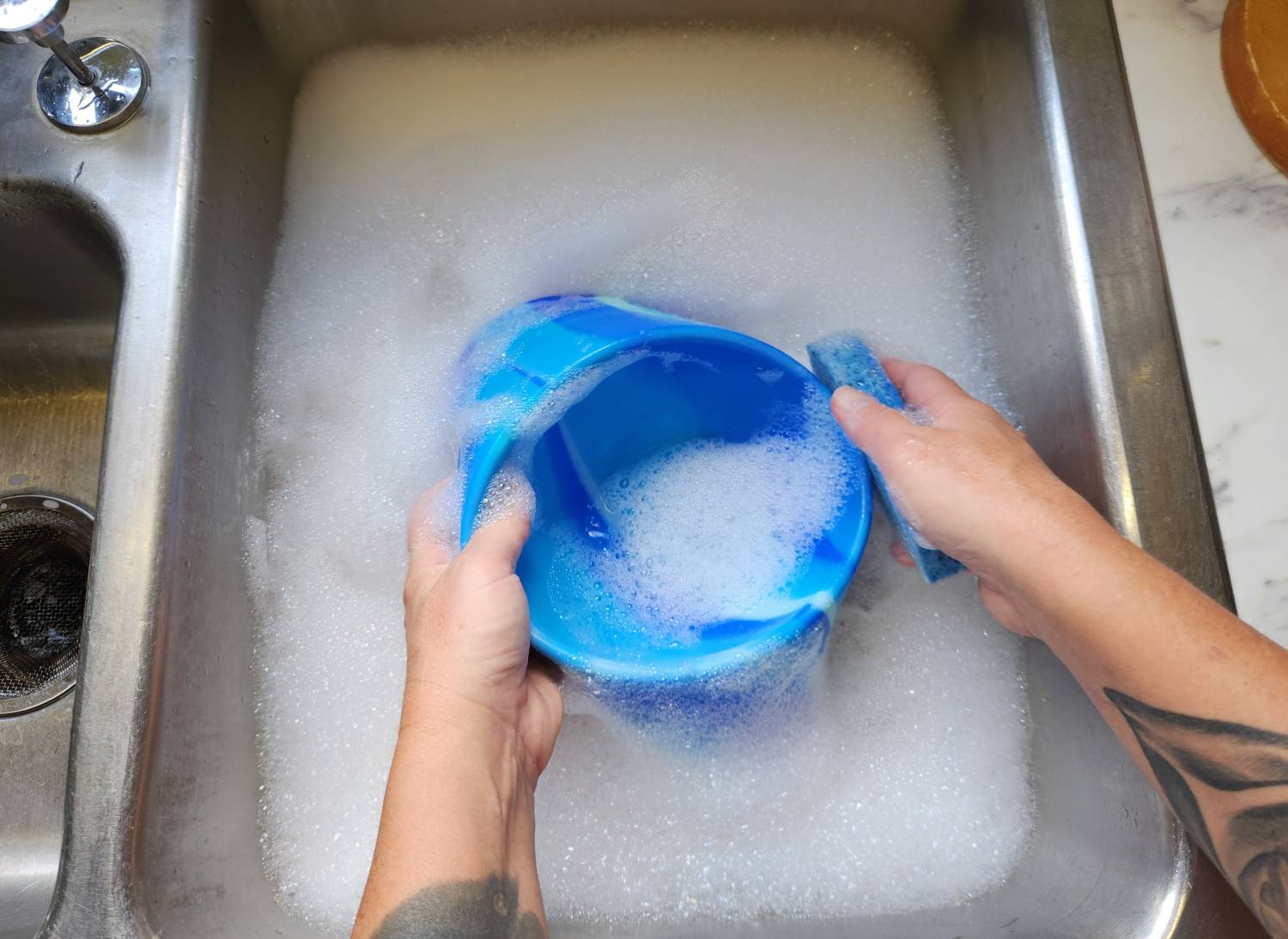

Our Experience With Silipint’s Aqua-Fur Dog Bowl
As a lifelong dog lover and outdoor enthusiast, I have always loved taking my pups along on my adventures. And though it was over 25 years ago, I still remember vividly the very first collapsible dog bowl I ever purchased. I found it in a mail-order catalog – a vinyl-lined canvas material with a rim that folded inward to make it flat for storage. Sure, it could hold food and water, but it wasn’t good at holding its shape, meaning I had to manually keep the mouth of it open while my dog ate or drank from it. The interior vinyl also deteriorated over time until it cracked and would no longer hold water. Fortunately, it was cheap, but you get what you pay for…
Since my first collapsible bowl wore out, I’ve been traveling with just their regular bowls, or small Tupperware if I need to save space – not the most convenient option, I admit, but better than wasting money on another disappointing product. Then a couple years ago while working as a vet tech, I was given a bunch of “swag” during October’s National Veterinary Technician Week, and one of the items was a collapsible dog bowl. At first, I was thrilled, and eager to try it out on a road trip or camping excursion. The free bowl was double-sided with a clamshell design and was supposed to close into a disc shape – however, the rubbery material was extremely flimsy, and not only did it not hold a compressed shape, but it often caused spills when in use.
Fast forward to the arrival of our new Aqua-Fur Dog Bowl! I wasn’t sure what to expect when I ordered this bowl… it looked like a great product, and had great reviews, but I had been let down before by other brands. Fortunately, this perfectly designed bowl surpassed all my expectations. Right away, I could tell this was a much sturdier bowl than the others I have tried. It holds its shape very well and does not collapse under the weight of food or water. It was a little tricky getting the hang of how to fold and secure it for storage, but I found a handy YouTube video to help me out, and with a few minutes of practice, I now find folding it to be a breeze! I also appreciate how easy to clean this bowl is – I have washed it in both the dishwasher and by hand in the sink, and it still looks brand new with its vibrant blue tie-dye pattern “Arctic Sky.” Now that Fall has finally arrived in Florida, I am excited to take this handy and innovative bowl on lots of dog-friendly excursions!


Conclusion
The Silipint Aqua-Fur Dog Bowl is a practical and stylish travel bowl that beats the competitors’ designs in both durability and safety. At around $15 a bowl, it is also affordable for any dog owner, and the perfect addition to any pet-friendly travel gear for its space-saving capabilities. If you’re looking for a dog bowl to take with you on road trips, hikes, or even the dog park, the Aqua-Fur Dog Bowl is the best option available!
The post Silipint Silicone Aqua-Fur Dog Bowl Review 2024: An Expert’s Breakdown by Gabrielle McGhee appeared first on Dogster. Copying over entire articles infringes on copyright laws. You may not be aware of it, but all of these articles were assigned, contracted and paid for, so they aren’t considered public domain. However, we appreciate that you like the article and would love it if you continued sharing just the first paragraph of an article, then linking out to the rest of the piece on Dogster.com.
The Honest Kitchen & Cozymeal Partner Up For National Dog Week 2024: A Cooking Class Experience
The post The Honest Kitchen & Cozymeal Partner Up For National Dog Week 2024: A Cooking Class Experience by Gabrielle McGhee appeared first on Dogster. Copying over entire articles infringes on copyright laws. You may not be aware of it, but all of these articles were assigned, contracted and paid for, so they aren’t considered public domain. However, we appreciate that you like the article and would love it if you continued sharing just the first paragraph of an article, then linking out to the rest of the piece on Dogster.com.
Click to Skip Ahead
To celebrate September’s National Dog Week this year, human-grade pet food manufacturer The Honest Kitchen teamed up with online culinary platform Cozymeal to bring a complimentary virtual cooking class to life. Though Cozymeal typically only offers classes on preparing human dishes, this special edition Zoom class walked its participants through the preparation of a full-course meal for their dogs and featured some of The Honest Kitchen’s most popular dehydrated products in addition to some regular ingredients from the grocery store.
The dishes created during the class were a Doggy Hot Toddy appetizer, a main course of meatloaf and mashed potatoes, and a decadent dessert of Blueberry Celebration Cake. All three meals were, of course, human-grade and nutritious, in keeping with the spirit of National Dog Week, which is to encourage people to find new ways of enhancing their dogs’ lives and well-being. Through use of The Honest Kitchen’s exceptional products and Cozymeal’s top-tier chef educator, Stacy D., this class not only provided a fun experience learning to cook for our dogs in a healthy way, but also brought to the table a beneficial way to bond with our pets.

About The Honest Kitchen

The Honest Kitchen was born in the home of Lucy Postins in 2002. Armed with an educational background in animal nutrition, Postins’ goal was to improve the convenience of prepping a nutritionally balanced raw meal for her own dog, Mosi. With her success came the idea that she could put other pets on the path to good health through a healthy diet. The Honest Kitchen went on to become the first dog food brand in history to obtain FDA approval to list their products as “human grade” on the packaging, and they add no fillers or GMO ingredients. They carry a wide range of supplements, wet food, kibble, dehydrated meals, and toppers with carefully sourced ingredients prepared in facilities that meet the highest human food standards.

About Cozymeal

Cozymeal is an online platform with a mission to provide users with easy access to top-tier culinary experiences. After 10 years in the marketplace, this website has become the premier destination for both foodies and kitchen newbies to find local cooking classes, food tours, and private chefs, as well as virtual cooking lessons. Most of the options are for humans, but Cozymeal also has options that revolve around home-cooked dog food or treats, which was my introduction to this revolutionary company. Cozymeal’s broad range of available bookings with varied price points makes this website a great platform to find fun and rewarding cooking experiences, no matter your skill level, budget, or goals. Through Cozymeal, you can hire a private chef for a dinner party, take your friends on a food tour, or practice team building with your coworkers…or, like I did, learn how to cook at home without anyone watching!

Our Experience with The Honest Kitchen & Cozymeal’s Online Cooking Class
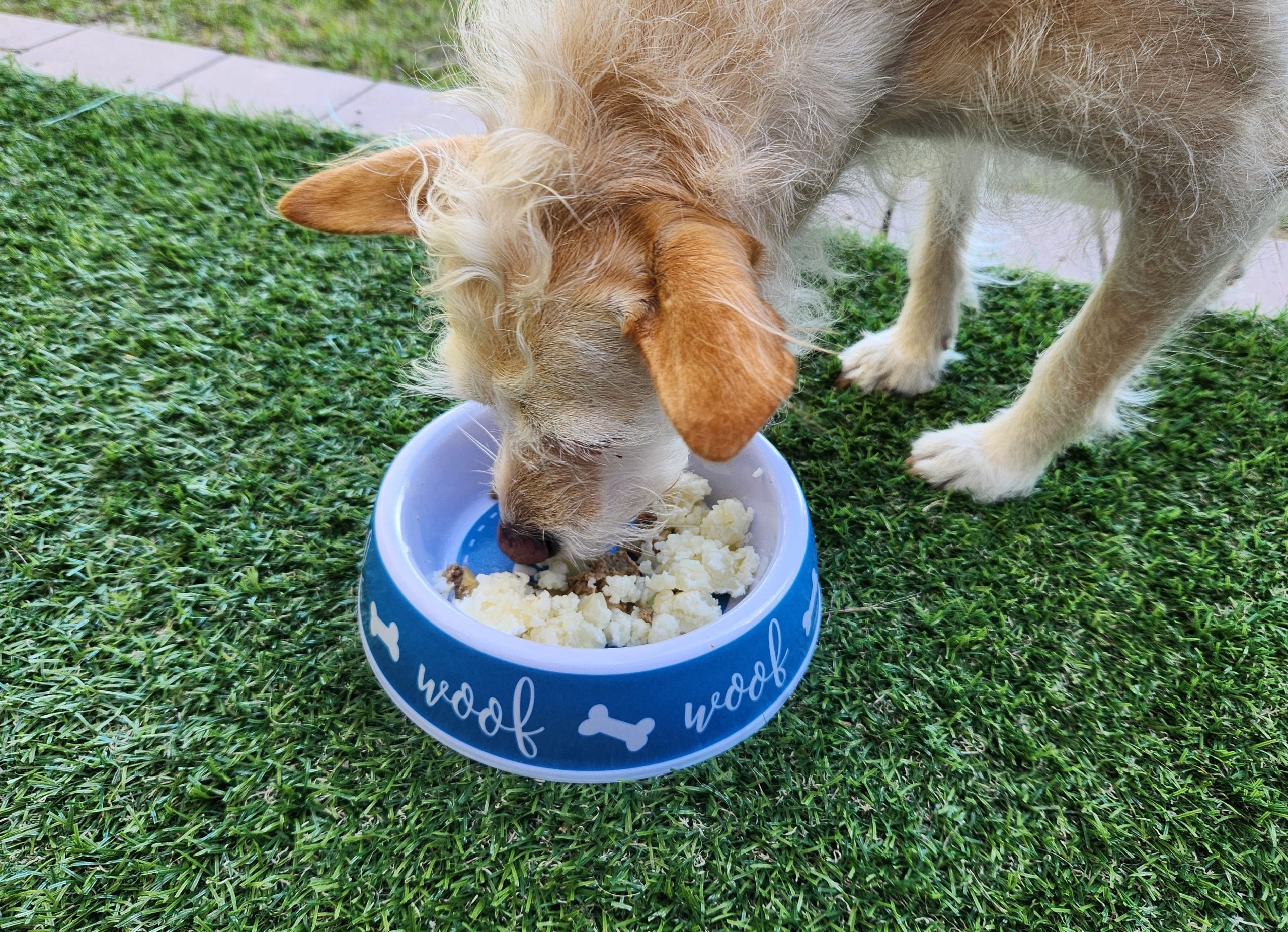
To be honest, I have never been a good cook. My go-to is usually spaghetti, a dish that is pretty hard to mess up. A box of pasta, marinara in a jar, some garlic toast, and TA-DAAA – dinner is served! Well, several months ago, I decided to start cooking fresh meals for my dogs. I was hearing more and more about how a lifetime of processed food is detrimental to the health of our canine companions, and I wanted to do better for them. But where do I start as a lackluster chef? How do I make sure what I’m cooking is healthy for them? How can I create something tasty my dogs will actually eat?
I was recently invited to attend a virtual cooking class, a collaboration between Cozymeal and The Honest Kitchen, a human-grade pet food manufacturer. The class theme was “Tasty Recipes To Celebrate National Dog Week,” and as someone who already likes to prepare fresh food for my three dogs – Turtle, Rooney, and Candy – I was all in!
I was familiar with The Honest Kitchen, but Cozymeal was new to me. Many of the required ingredients were things I already had in my kitchen, and those I had to purchase were nothing expensive – in total, I spent less than $40 shopping for the class.
Since I had my ingredients prepped ahead of time, the pace of the class ended up being just right, and there were even a few 5-minute breaks during which I was able to do a little kitchen cleanup. The instructor was very kind and personable, and showed us her little doggie that she was cooking for at home. Class participants even sent photos of their own dogs to the Zoom chat, so we enjoyed some cute photos while we learned.
Chef Stacy walked us through making a 3-course meal for our dogs, which included a Doggy Hot Toddy, Meatloaf and Mashed Potatoes, and Blueberry Celebration Cake. Each dish was made using a combination of human ingredients and some products from The Honest Kitchen. Everything was easy to prepare and came out looking and smelling amazing. The dogs all enjoyed this new culinary experience and there was no food left in anyone’s bowl, but it’s safe to say the meatloaf – made with lean ground beef and The Honest Kitchen’s dehydrated beef formula – was the crowd favorite! The portions were also generous, and I was able to feed the dogs for multiple meals using the blueberry cake and meatloaf. Now that I’ve had this awesome Cozymeal experience with my dogs, I want to sign up for the human version!


Conclusion
Food is a basic human need but can also be transformative, physically and emotionally. Experiences around food can shape how we feel about the world, which is also true for our canine companions. Preparing a special meal for your dog is a wonderful way to bond, and intimate dining experiences can have the same effect for humans. Both Cozymeal and The Honest Kitchen know the value of crafting culinary experiences around love, and their platform helps everyone discover a love of food.
The post The Honest Kitchen & Cozymeal Partner Up For National Dog Week 2024: A Cooking Class Experience by Gabrielle McGhee appeared first on Dogster. Copying over entire articles infringes on copyright laws. You may not be aware of it, but all of these articles were assigned, contracted and paid for, so they aren’t considered public domain. However, we appreciate that you like the article and would love it if you continued sharing just the first paragraph of an article, then linking out to the rest of the piece on Dogster.com.
Adopting Gizmo: My Scruffy Little Maniac
The post Adopting Gizmo: My Scruffy Little Maniac by Kate MacDonnell appeared first on Dogster. Copying over entire articles infringes on copyright laws. You may not be aware of it, but all of these articles were assigned, contracted and paid for, so they aren’t considered public domain. However, we appreciate that you like the article and would love it if you continued sharing just the first paragraph of an article, then linking out to the rest of the piece on Dogster.com.
Welcome to the Wednesday Dogs of Dogster! Every Wednesday, we share a story from one of our Dogsters. This week is about Kate & Gizmo, her scruffy Pug mix.
Hey Dogsters! I adopted my first dog, a scrappy Pug/American Eskimo/Poodle/etc. mix, two years ago, and he’s brought so much joy (and terror – those puppy teeth are sharp!) into my life every day since. I grew up with cats and dogs, and I’ve always wanted to have one of my own. But it took me a while to decide that I was ready to provide a pup with the kind of life they deserve…
In the end, a little bit of inspiration and logistics conspired to bring Gizmo into my life. Lucky me! Here’s the story:
Deciding to Adopt a Dog: Inspiration & Logistics
Meeting Chester
During those long, slow pandemic summers and falls in 2020 and 2021, my friends and family had a lot of socially distanced dinner parties in backyards. I met Chester at one in my parents’ yard and it was love at first snuggle. He’s a sleepy little lap dog with human-like eyes and incredibly coarse hair.
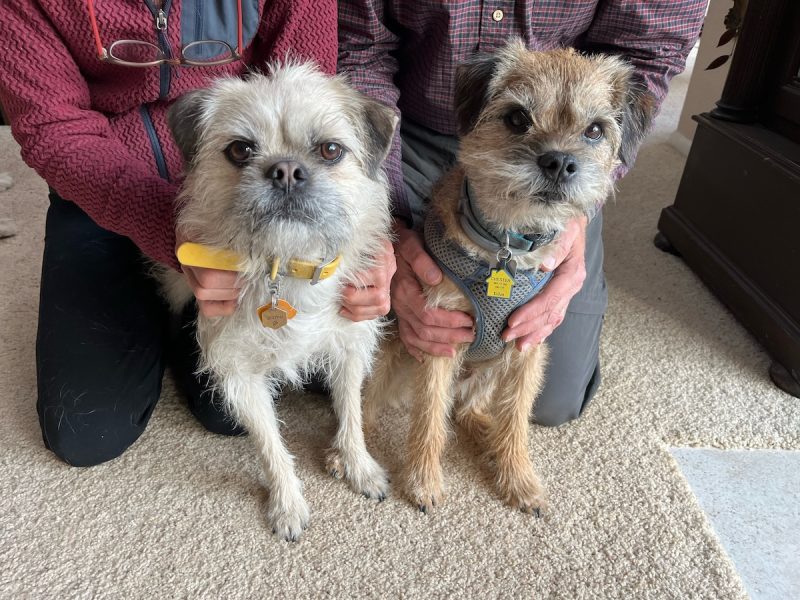
I will admit to having been anti-small dog growing up, since we only ever had 40+ pounders and the main small dogs I knew were a bit yappy (my neighbor had a series of dachshunds, all named Moxie, with whom I never quite bonded). But Chester was something else, and he single-pawed-ly thawed my heart to the little guys.
Dog Sharing: The Logistics
The most important piece of the puzzle was the boring stuff: logistics. I love to travel and I’m not amazing with routine, plus I’m not huge on spending money. The solution to all of this was dog sharing! I already shared the rent on a cute little Victorian house with my best friend Chelsea, and she wanted a dog, too. Enter: dog sharing! We agreed to adopt a dog and share the costs and care.
Finding the Right Dog
Once we really started looking, we quickly determined that Border Terriers are not ideal dogs for first-time owners (Google hand-stripping, seriously!), on top of which they almost never show up at rescues in the US. Plus, it turns out that Chester is not a typical Border Terrier: they’re famous escape artists, and not all of them are cuddly or people-oriented.
So we started searching the local dog rescue pages for a similarly small, adorable pup. The first adoptable dog I fell in love with was a hilarious little guy named Mr. George.

But adopting rescue dogs in Colorado is basically a competitive sport, so while I was still in the virtual-home-visit-and-interview phase, he got scooped up. Luckily, I also had my eye on another little guy…
The rescue was calling him Junior, and he was new to the website, listed as a one-year-old Pug mix. You may have seen his rescue site pictures in our introduction post a few weeks ago:

To say he was adorable would be a major understatement! Plus, he was red flag-free (important to me as a first-time dog owner) and listed as having all the good things: good with cats, kids, and other dogs.
Gotcha Day
After Big Bones Canine Rescue brought “Junior” from an overcrowded shelter in Texas, they neutered him and let him recover at a foster home for a few days. The first day he was available for visits at the rescue, my friend and I called to set up a time. It was a workday and I had things to do (and no doggy supplies prepared), but the woman on the phone said he’d likely be adopted before the weekend came, so we jumped in the car.

Long story short, Gizmo came home with us that same day. Since we didn’t have any supplies, I snuggled on him in the car while my friend grabbed some food and toys at the local pet store. He was a grinning little maniac the whole car ride, panting happily, but once we got home, it seemed like it started to set in that this wasn’t just a foster visit.
A Few Weeks of Terror
In the first few weeks, Gizmo was absolutely bonkers. He chewed everything, including a power cord that briefly caught fire, peed on everything, and was generally a mouthy little monster. But he was also snuggly and sweet right away, and he settled in pretty much following the “three days, three weeks, three months” rescue dog schedule.
When he first came home, he had picked up kennel cough from other dogs at the shelter. So not only was I just some random lady who’d kidnapped him from his foster family, but I was also trying (largely unsuccessfully) to feed him pills, hidden in peanut butter and other treats. He also needed some serious grooming and wasn’t comfortable with me touching his paws or his belly. When he was unsure, his sharp little teeth would come out, to play or just to communicate. I started wearing rubber bracelets designed for doggy teething so I could redirect his chompers.

Looking at pictures from that time now, I can see how anxious he was, and all the terrorizing makes a lot of sense. Luckily, that era of Gizmo is long behind us now!
Settling In
These days, he’s a secure, happy little guy who loves to sleep on his many beds and couches while I work. He’s a charismatic dog who makes friends everywhere he goes, and he’s never met a lap he couldn’t turn into a day bed. Because of his long legs, he can hike pretty far, and he has to sniff absolutely everything we pass on our daily neighborhood walks. And he loves a good belly rub!

Don’t forget to check back in a few weeks: I’ll share the story of Gizmo’s (adorable) 15 minutes of fame with People Magazine!
The post Adopting Gizmo: My Scruffy Little Maniac by Kate MacDonnell appeared first on Dogster. Copying over entire articles infringes on copyright laws. You may not be aware of it, but all of these articles were assigned, contracted and paid for, so they aren’t considered public domain. However, we appreciate that you like the article and would love it if you continued sharing just the first paragraph of an article, then linking out to the rest of the piece on Dogster.com.
3D Tech Gives Dogs a New Leash on Life – The Story of Oslo & WIMBA
The post 3D Tech Gives Dogs a New Leash on Life – The Story of Oslo & WIMBA by Dogster Team appeared first on Dogster. Copying over entire articles infringes on copyright laws. You may not be aware of it, but all of these articles were assigned, contracted and paid for, so they aren’t considered public domain. However, we appreciate that you like the article and would love it if you continued sharing just the first paragraph of an article, then linking out to the rest of the piece on Dogster.com.
Click to Skip Ahead
Meet Oslo, a 5-year-old Australian Shepherd, who loved nothing more than adventuring through the mountains of Haute-Savoie and the Alps with his owner. Unfortunately, his adventure-seeking lifestyle was halted when he suffered a serious injury, partially rupturing the tendons in his right front paw. Even after surgery, Oslo was left with carpal joint hyperextension, severely limiting his mobility.
Oslo’s owner was determined to find him support, and that’s where he found WIMBA. The company specializes in custom orthotics using advanced 3D scanning and printing technology. For Oslo, WIMBA designed an orthotic custom-made for his condition and needs, complete with adjustable features for the best fit and support, which enabled him to get back to exploring the mountains.
“I’ve rediscovered my dog.” Oslo’s owner explained happily. “Thanks to WIMBA, he’s back to being the adventurous dog he once was.”
How Does 3D-Printing Technology Impact Veterinary Care?

3D printing is becoming increasingly popular in veterinary care, opening up new possibilities for pets with complex medical conditions, many of which were previously too difficult or expensive to manage.
WIMBA, a startup from Poland, is using this cutting-edge technology to design and create custom orthotics and prosthetics for pets, giving them individualized and tailored solutions to vastly improve their quality of life.
Traditional methods, like using plaster casts, can be slow and stressful for the animal and often involve anesthesia. On the flip side, 3D printing allows for quick production of precise, custom-fit supports. These are not only effective but also comfortable, both of which are top priorities for pet parents today.
Pet parents around the planet have been faced with difficult choices when it comes to treating or managing certain medical conditions that require orthotics or prosthetics, so these technologies make pet care and recovery more accessible.
What Does WIMBA Do?

WIMBA’s approach uses 3D scanning and printing technologies combined with AI, enabling the creation of orthotics and prosthetics that are lightweight, durable, and tailored to the unique needs of each animal.
The process begins with WimbaSCAN which transforms how limb measurements are taken. Using just a smartphone, WimbaSCAN captures a precise 3D scan of a pet’s limb in a matter of seconds, eliminating the need for traditional methods like plaster casting. This approach ensures an accurate fit from the very start, leading to the creation of custom orthotics that perfectly match the pet’s anatomy.
The Booming Pet & Vet Tech Industries
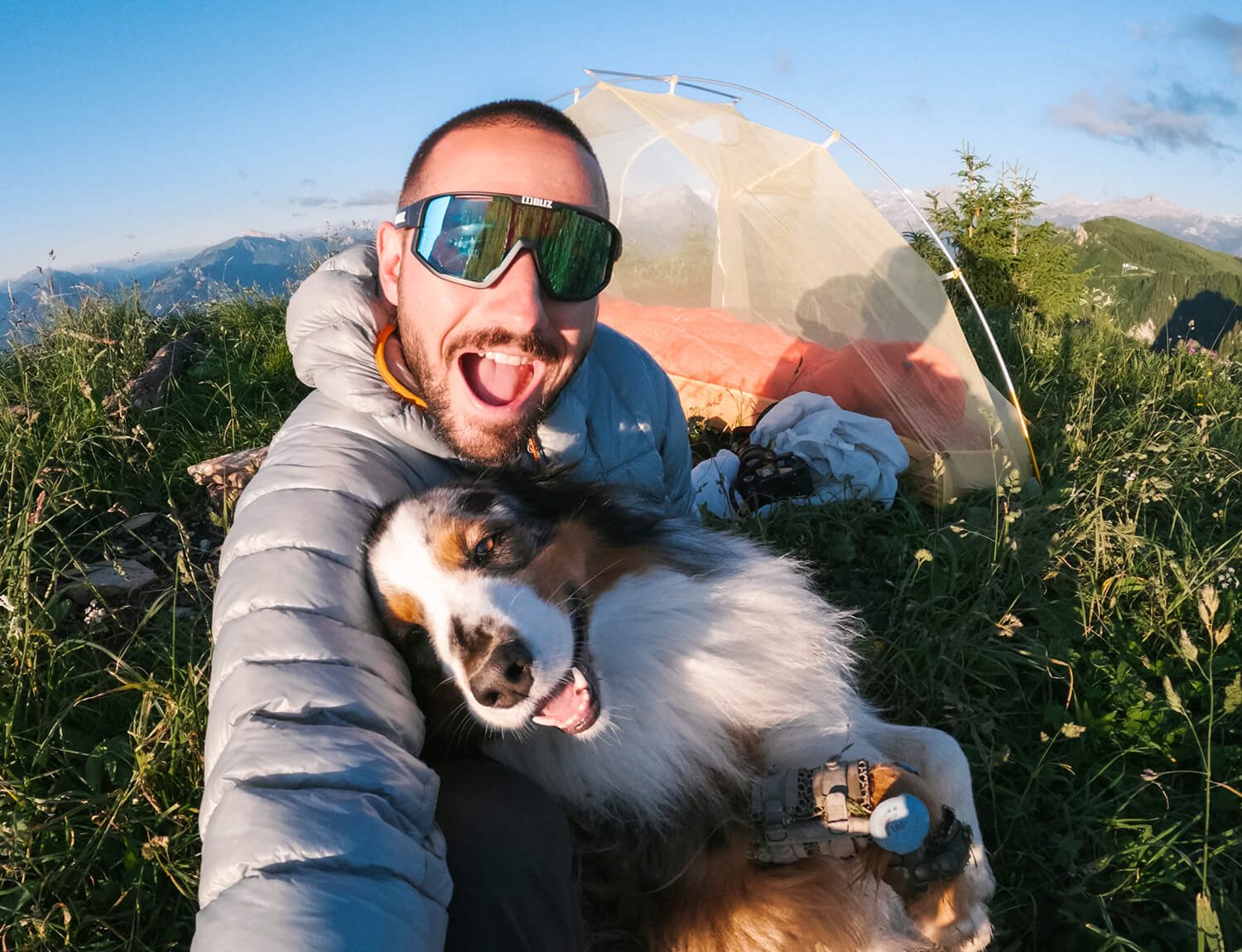
The pet care industry is booming, with more people treating their pets like family members and expecting the best care. The global pet market is set to hit $360 billion by 2030, and veterinary orthopedics are projected to grow to $20 billion, meaning the demand for innovative pet solutions like 3D-printed orthotics and prosthetics is skyrocketing. Pets all over the planet are about to live happier, more accessible lives.
More About WIMBA

WIMBA specializes in orthopedic products for pets, creating custom orthotics and prosthetics that help animals regain mobility. Operating in over 20 countries across three continents, WIMBA offers a range of products to meet various needs.
They’ve revolutionized the way measurements are taken by ditching traditional plaster casting for 3D scanning and printing. With WimbaSCAN, measurements are taken in just 15 seconds using a smartphone, making the process quicker and more comfortable for the animal. Their products, made with HP Multi Jet Fusion technology, are lightweight, durable, and waterproof, ensuring maximum comfort for pets.
WIMBA currently offers five types of devices: knee braces, tarsal orthotics, carpal orthotics, cervical collars, and prosthetics, all of which are custom-made to order for the individual’s needs. By incorporating AI in different areas of their business, WIMBA is set on improving veterinary care and rehabilitation results.
For more info about WIMBA and their work in pet tech, please visit www.wimba.vet.
Images provided by Wimba
The post 3D Tech Gives Dogs a New Leash on Life – The Story of Oslo & WIMBA by Dogster Team appeared first on Dogster. Copying over entire articles infringes on copyright laws. You may not be aware of it, but all of these articles were assigned, contracted and paid for, so they aren’t considered public domain. However, we appreciate that you like the article and would love it if you continued sharing just the first paragraph of an article, then linking out to the rest of the piece on Dogster.com.
How to Check & Care For Pet Stitches After Surgery: Our Vet Explains Stages of Healing
The post How to Check & Care For Pet Stitches After Surgery: Our Vet Explains Stages of Healing by Dr. Karyn Kanowski, BVSc MRCVS (Vet) appeared first on Dogster. Copying over entire articles infringes on copyright laws. You may not be aware of it, but all of these articles were assigned, contracted and paid for, so they aren’t considered public domain. However, we appreciate that you like the article and would love it if you continued sharing just the first paragraph of an article, then linking out to the rest of the piece on Dogster.com.
Click to Skip Ahead
When you bring your pet home from surgery, it’s normal to have worries, questions, and concerns about how to look after them while they recover. One aspect of post-operative care is keeping an eye on their stitches, so it helps to know exactly what you need to be looking out for.
The following is a general guide to the dos and don’ts of post-operative wound management, including the basics of day-to-day care, and when to call your vet.

Stages of Wound Healing
Whether it’s an injury or a surgical cut, the skin goes through the same basic stages of healing. How long that healing takes will be dependent on a number of factors, including:
- The size of the wound
- The shape of the wound
- The depth of the wound
- The location of the wound
- The cleanliness of the wound
- Disruption to wound healing
- The health of the individual
For example:
| Cat Castration Wound | Dog Bite Wound over Knee |
|
|
| Wound heals in 3-7 days | Wound heals in 7-21 days (or more) |

No matter the type of wound we’re dealing with, all full-thickness skin wounds go through the following three stages of healing:
1. Inflammation
Blood vessels initially constrict to control bleeding, but then dilate to allow white blood cells (eg. neutrophils, macrophages) to migrate to the area to deal with any bacteria, damaged tissue, or contamination—this is when wounds become swollen and inflamed. If there is a lot of bacteria or contamination, more white cells are recruited, resulting in pus. In clean, sterile surgical wounds, this phase should be minimal.
2. Proliferation
In a healthy wound, fibroblasts (the cells involved in forming connective tissues) and capillaries (tiny blood vessels) come into the area to form a scaffold for other cells to grow over and fill in any missing or damaged tissues. The proliferation stage can take as little as 48 hours in a surgically closed incision. In wounds that are left open, the scaffold, called granulation tissue, needs to fill the wound before new skin cells (epithelial cells) can grow over the top.
3. Remodeling
Scar formation: new collagen fibers are laid down along lines of tension to provide strength to the newly formed skin. In large wounds, this process can take up to 2 years, and the scar tissue will always be a little weaker than the original skin.

Different Types of Wound Closure
Depending on the type of surgery, wound location, incision size, and the surgeon’s preference, your dog may go home with nylon skin sutures, intradermal skin sutures (dissolvable sutures within the skin layer instead of on the outside of the skin), skin staples, or even tissue glue.
The type of wound closure shouldn’t have a significant impact on how the wound heals, but some dogs will be more sensitive to certain suture materials. The most important thing is to keep a close eye on the wound and contact your vet if you notice anything that doesn’t look right.

 Speak To a Vet Online From the Comfort of Your Couch!
Speak To a Vet Online From the Comfort of Your Couch!
If you need to speak with a vet but can’t get to one, head over to PangoVet. It’s an online service where you can talk to a vet online and get the personalized advice you need for your pet — all at an affordable price!
Pros and Cons of Keeping Wounds Covered
You might have assumed that all wounds would be covered after surgery, but that’s not always the case. For starters, it’s not always easy to apply a dressing or bandage to certain parts of your dog’s body, and sometimes, we want to be able to see the wound all the time. Here are some pros and cons of covering a wound:
- Protection against contamination
- Protection against abrasion
- Added layer of protection from scratching or licking
- We may not immediately notice bleeding/swelling/redness
- Wound coverings/bandages can lead to pyoderma
- Dogs are often more bothered by a wound dressing than by the wound itself
How To Check Your Dog’s Wound

Your vet will go over all the things you need to do to help your dog recover from their surgery, as each case will be different, depending on the individual pet and the type of surgery they have had. Some dogs will go home with a dressing or bandage over the wound, while others will be left open. Depending on the location of the surgical wound, your dog may be required to wear a surgical suit or e-collar. It is important to leave this in place, particularly overnight or when you are out, as a dog can do a LOT of damage to a wound in a very short period when left unsupervised. If you are struggling to keep a collar or suit on your pet, talk to your vet about some alternatives. You might even want to fashion a custom collar at home!
Let’s talk about what a clean, surgical wound should look like at different stages of healing, and what you need to be on the lookout (BOLO) for.
Day 1-3: Inflammation
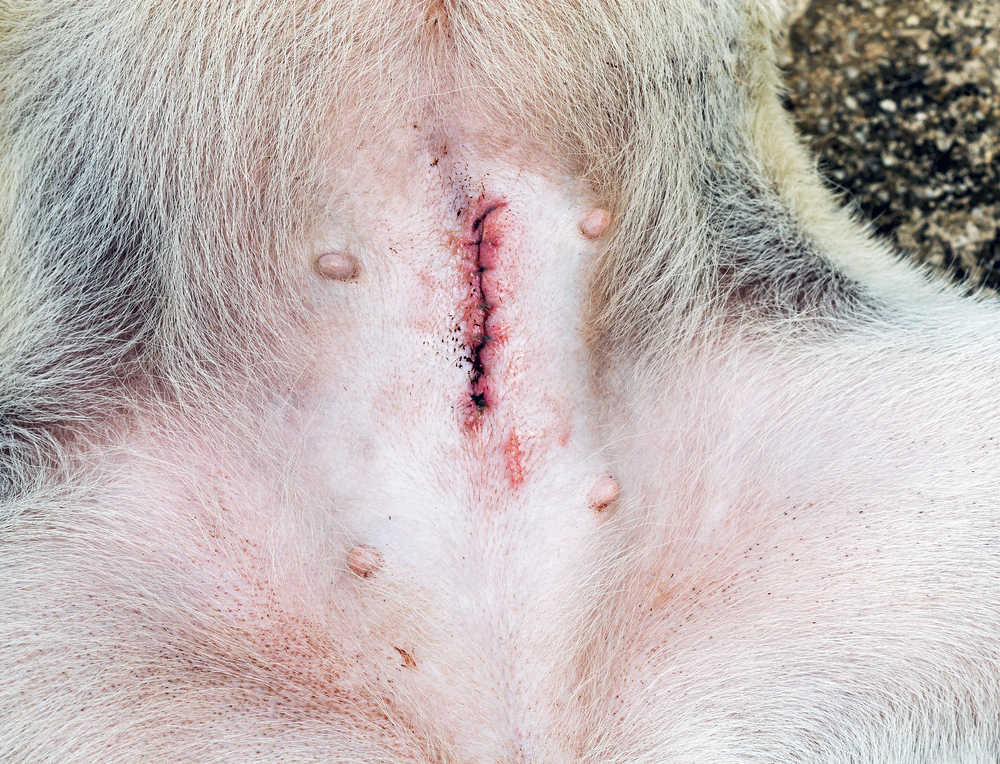
During the first few days, it is quite normal for the edges of the wound to look a bit pink and inflamed.
- Swelling – the sutures (stitches) shouldn’t be digging into the skin
- Pain – the wound may be tender, but shouldn’t be excessively painful
- Discharge – there may be a small amount of blood-tinged fluid from the wound, but there should not be much fresh blood or pus
Day 4-7: Proliferation
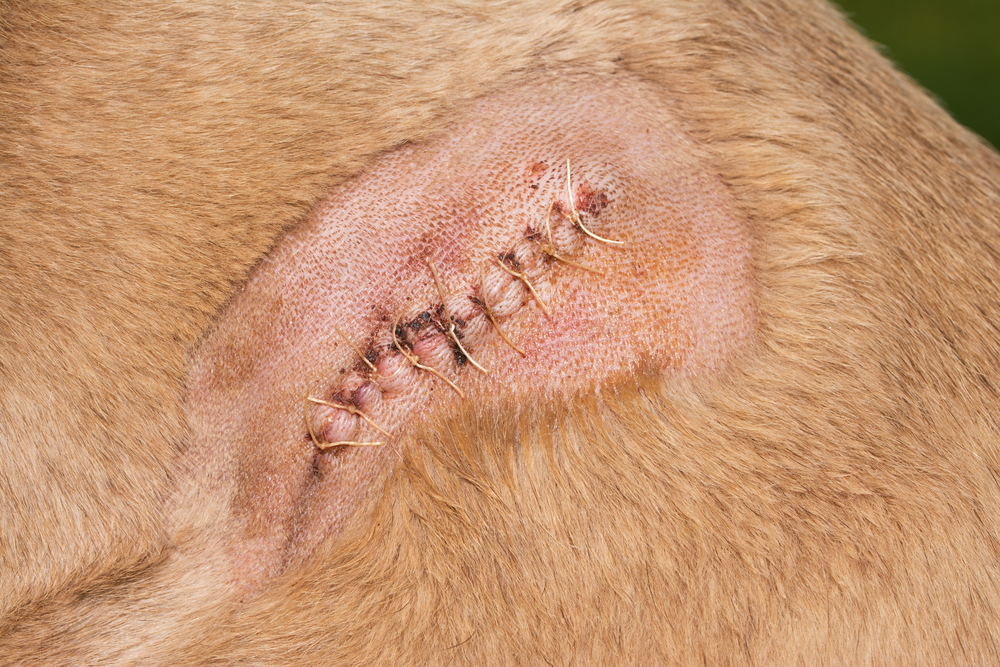
This is when your dog might find the wound itchy or irritating, as active healing begins, and shaved hair begins to grow back.
- Licking, scratching, chewing
- Wound or sutures pulling apart
- Large swellings along the incision line
Day 7 → : Remodeling

This is the stage where the sutures are no longer needed, although we usually leave them in for another 5-7 days to be safe. You should be able to put gentle pressure on the wound without any discomfort, and the incision should be knitted together.

Common Surgical Wound Complications
Wound Breakdown
Also known as wound dehiscence, this is the partial or total failure of wound closure. It can happen for many reasons, such as infection, failure of sutures, or too much running around. The treatment will depend on where the dehiscence has occurred, how large it is, and what stage of healing the wound is at.
Internal wound dehiscence will almost certainly require surgery, while a breakdown of the skin incision might be treated with a dressing, skin staple, or by completely re-closing the wound.
Seroma
A common complication of surgery, particularly on abdominal wounds or where a large mass or tumor has been removed. A seroma is a collection of inflammatory fluid that has rushed to the incision site to help heal the wound. In most cases, rest and anti-inflammatory medication will see the seroma resolve on its own, but they occasionally need to be drained.
Infection
Post-operative infections aren’t as common as you might expect, given that dogs are not necessarily the most fastidiously clean of creatures! But, they do happen and need to be treated quickly. If your dog’s wound is red, warm, or swollen, or if there is a pink, yellow, or creamy discharge, call your vet right away.
Suture Reactions

Suture material has come a long way since catgut was the mainstay of wound closure. Even so, some individuals will be more sensitive to suture material, which can result in inflammation around the incision and lumps/bumps forming along the suture line, which may be quite mild or severe. This often occurs during the proliferation stage of healing. Always check with your vet if you are worried about any swelling on your dog’s wound, but it is not uncommon for small, painless bumps to appear whilst the incision is healing.

Frequently Asked Questions
Should I Clean The Wound?
Unless specifically directed to by your vet, you shouldn’t need to clean your dog’s surgical incision. A small amount of crusted blood or scabbing is normal, and it is better to leave these in place rather than risk contaminating the wound or disrupting healing by trying to pick them off.
If your dog’s wound becomes dirty, the best thing to do is dip some cotton wool in sterile saline or cooled boiled water (no need for it to be salty), squeeze out excess water, and gently dab the skin around the wound. Avoid touching the incision itself.
Remember, your dog might be quite tender, so it’s a good idea to approach the wound slowly, using a couple of ‘warm up’ pieces of cotton wool to work your way closer to the wound, before using a fresh piece to clean around the incision.
How Often Do I Need To Go Back For A Check-up?
This will very much depend on the age and health of your dog, and the type of surgery they have had. For routine procedures like a spay or castration, most vets will recommend a post-op check after 3 and 7 days, with sutures being removed after 14, but every vet and practice is different.
Most importantly, if you are worried about your dog’s wound or any other aspect of your dog’s recovery, don’t wait for your next appointment; contact your vet right away. If your vet is unavailable, there are always online veterinary services that can assist you.
How Long Does It Take For Dissolvable Sutures To Dissolve?
Different suture material types are designed to last longer than others, depending on the job they are doing, and they are designed to have a minimum amount of time before they start to break down. For example, suture materials used in sewing up intestines will start to break down after a couple of weeks, as the tissue heals quickly, and we don’t want suture material to cause a problem. In the deepest muscular layer of the abdomen, the suture material used won’t start to break down for at least 4-6 weeks, while the material used in intradermal sutures breaks down after 2-3 weeks. However, how long some suture material lasts can vary, and it isn’t uncommon to still feel suture material in the deepest layer of a spay scar many months after the surgery!
Should I Cover The Wound With Ointment?
Never put any ointments, gels, or creams on a surgical incision unless specifically instructed to by your vet. Most skin preparations for humans are not suitable for dog skin and will do more harm than good.


Final Thoughts
Hopefully, you are feeling more prepared than ever to monitor your dog after surgery. Often, the most challenging part of a dog’s surgical recovery is trying to stop them from running around within a day or two! It is extremely important to use any collars or suits to prevent your dog from licking or scratching their wound, even if they’re not a fan of their new fashion accessory. It is far better to have a dog that resents their surgical collar than one that needs to have another surgery.
Your vet would always prefer to examine your dog or even look at a photo than have you worrying about your dog’s wound and not getting in touch, so don’t hesitate to call them if you’re at all worried.
Featured Image Credit: Jus_Ol, Shutterstock
The post How to Check & Care For Pet Stitches After Surgery: Our Vet Explains Stages of Healing by Dr. Karyn Kanowski, BVSc MRCVS (Vet) appeared first on Dogster. Copying over entire articles infringes on copyright laws. You may not be aware of it, but all of these articles were assigned, contracted and paid for, so they aren’t considered public domain. However, we appreciate that you like the article and would love it if you continued sharing just the first paragraph of an article, then linking out to the rest of the piece on Dogster.com.
My Dog Ate A Scrunchie: Our Vet Discusses Potential Risks, Signs & Next Steps
The post My Dog Ate A Scrunchie: Our Vet Discusses Potential Risks, Signs & Next Steps by Dr. Karyn Kanowski, BVSc MRCVS (Vet) appeared first on Dogster. Copying over entire articles infringes on copyright laws. You may not be aware of it, but all of these articles were assigned, contracted and paid for, so they aren’t considered public domain. However, we appreciate that you like the article and would love it if you continued sharing just the first paragraph of an article, then linking out to the rest of the piece on Dogster.com.
Click to Skip Ahead
This unassuming little hair accessory, created by the late Rommy Hunt Revson,1 was an essential item in the 1980s, the subject of ridicule in the early noughties, and is back with a vengeance in the 2020s. Just as it was in the time of The Goonies, Footloose, and Ferris Bueller, you would be hard-pressed today to find a bedroom, bag, or bathroom without at least one of these handy little hair ties. Unfortunately, we’re not always the only ones rummaging around in dark corners or under beds for a scrunchie, and they’re just the right size for a dog to play with and swallow.
If your dog has managed to ingest your favorite hair accessory, try not to panic. In the vast majority of cases, a scrunchie will find its way to the nearest exit, and it will be up to you to decide if you want to salvage it or dispose of it (no judgment here). However, there may be cases where a scrunchie can wreak havoc on the digestive tract, so it’s best to know what to watch out for.

What Happens If My Dog Swallows A Scrunchie?
Unless you have a particularly small dog or exceptionally large scrunchie, there is a good chance that it will gradually make its way through the digestive tract. Sometimes, items like this that are not able to be broken down by stomach acids, may stay in the stomach for a day or two, and will likely take a few more days to make their way through the intestines. But if it’s been more than 4-5 days since your dog swallowed them, it’s time to contact your vet.

 Speak To a Vet Online From the Comfort of Your Couch!
Speak To a Vet Online From the Comfort of Your Couch!
If you need to speak with a vet but can’t get to one, head over to PangoVet. It’s an online service where you can talk to a vet online and get the personalized advice you need for your pet — all at an affordable price!
If your dog isn’t so lucky, it is possible that a swallowed scrunchie could cause a blockage in the esophagus, stomach, or intestines. Dogs that are very small, have health issues, or a history of intestinal problems or surgery, have a higher risk of complications, and you should contact your vet immediately.
- Regurgitation (food/water expelled without abdominal effort)
- Difficulty swallowing
- Exaggerated swallowing
- Drooling
- Gagging/coughing
- Inappetence
- Abdominal discomfort or pain
- Rigid abdomen
- Vomiting
- Drooling
- Passing no or very small amounts of feces
- Panting
- Dehydration – tacky gums, prolonged skin tent
If the scrunchie gets stuck in the colon, you may see signs of constipation, like squatting repeatedly and straining to defecate. It will likely pass eventually, but they may need an enema or some lubrication to help.

Will My Dog Need Surgery?
If your dog develops an obstruction, surgery is a likely outcome. First, your vet will perform x-rays or an ultrasound to get an idea of where the obstruction is, and how best to treat it. Sometimes, administering intravenous fluids and lubricating medications may be enough to get the problematic piece of fabric to pass, but if there is no hope of the scrunchie making its way to the ‘exit’, surgery will be needed to retrieve them.
Left untreated, an obstruction can lead to intestinal rupture and potentially deadly peritonitis.
Should I Make My Dog Vomit?
If you have just witnessed your dog swallow a scrunchie (or any other non-food item) the first thing you should do is get in touch with your vet, as your next steps may depend on the age, health, and size of your dog, as well as the size of the scrunchie.
Never attempt to make your dog vomit at home unless specifically instructed to by your vet. Your dog may regurgitate or vomit the scrunchie up on their own, so be sure to supervise them closely. You don’t want to be waiting for something to pass that has already been ejected!

What Else Should I Watch Out For?
The most important thing to monitor is that your dog is eating, drinking, and going to the toilet normally and that they seem bright and well. If your dog seems off-color or uncomfortable at all, contact the vet straight away.
If your dog is comfortable and happy, it is vital to make sure they stay hydrated. The longer it takes for the scrunchie to travel through the intestines, the drier it will become, making it more difficult to pass. Making sure your dog is drinking plenty of water can really help things along.
Should I Feed My Dog?
Do not give them anything to eat until you have spoken to your vet.
If your dog is showing no signs of discomfort or an obstruction, feeding them little and often can help keep their digestive tract moving and speed up the passage of the swallowed item. It also allows us to see if your dog is still wanting to eat, or if they are having difficulty digesting food.

Conclusion
If your dog has swallowed a scrunchie, don’t panic. Most of the time, a scrunchie will be small and soft enough to pass through the digestive tract, but you should get in touch with your vet for specific advice and instructions. They may recommend that you bring your dog in to make them vomit, to give them fluids and medication, or to monitor them closely.
If your dog has any health issues, is particularly small in size, or has had previous intestinal surgery, it is imperative that you speak with your vet, as this will have a significant impact on how they will need to proceed.
Featured Image Credit: Julija Sh, Shutterstock
The post My Dog Ate A Scrunchie: Our Vet Discusses Potential Risks, Signs & Next Steps by Dr. Karyn Kanowski, BVSc MRCVS (Vet) appeared first on Dogster. Copying over entire articles infringes on copyright laws. You may not be aware of it, but all of these articles were assigned, contracted and paid for, so they aren’t considered public domain. However, we appreciate that you like the article and would love it if you continued sharing just the first paragraph of an article, then linking out to the rest of the piece on Dogster.com.
Can Dogs Get Psoriasis? Our Vet Explains
The post Can Dogs Get Psoriasis? Our Vet Explains by Dr. Amanda Charles BVSc MRCVS (Veterinarian) appeared first on Dogster. Copying over entire articles infringes on copyright laws. You may not be aware of it, but all of these articles were assigned, contracted and paid for, so they aren’t considered public domain. However, we appreciate that you like the article and would love it if you continued sharing just the first paragraph of an article, then linking out to the rest of the piece on Dogster.com.
Click to Skip Ahead
Psoriasis affects more than 3% of adults in the United States, most commonly causing inflamed, red, and scaly patches of skin. If you or someone you know suffers from this skin condition, you may wonder if it is something that can affect your dog as well. So, can dogs get psoriasis?
While dogs suffer from a variety of skin issues that can cause similar signs, psoriasis is not currently a recognized disease in dogs. There is only one scientific report to date of a dog with a psoriasis-like skin condition.
Read on to find out more about what might be causing your dog’s itchy, inflamed, scaly skin.

What Is Psoriasis?
Psoriasis in people is an immune-mediated disease; the body’s immune system is triggered and overreacts as if there is something harmful attacking the body.1 Researchers are still investigating what triggers this immune response, which involves both genetics and external factors like bacterial infections.
There are several different forms, but psoriasis typically causes patches of dry, scaly skin, which are usually red, inflamed, and often sore or itchy. Some people with psoriasis will also develop psoriatic arthritis, causing joint pain, swelling, and stiffness.
Can Dogs Get Psoriasis?
While there is discussion in online articles about canine psoriasis, it has not been identified or recognized as a disease that affects our canine companions.
When looking into animal models for research into this complex condition, researchers have only been able to identify a few anecdotal reports of spontaneously occurring conditions with psoriasis features in other species,2 and only one formal report has been published on a dog diagnosed with a “psoriasis-like” condition.3
There is also a rare canine skin condition called psoriasiform lichenoid dermatitis,4 which shares some similar clinical and histological features of human psoriasis, but this has only been recognized in Springer Spaniels.


What Canine Skin Conditions Look Similar to Psoriasis?
So, what is more likely to be the cause of your canine’s itchy, red, flaky skin? Dogs are prone to several conditions that can look very similar to human psoriasis. Let’s have a look at some of the more common causes of these skin signs in dogs:
Allergies
Like us, our dogs can develop allergies to things like pollen and house dust mites, as well as to foods (typically animal-based proteins). In dogs, the most common sign associated with allergies is itchy skin, so affected dogs often suffer from red, inflamed skin, hair loss, and skin infections. Canine atopic dermatitis (atopy), which is typically associated with sensitization to environmental allergens, has a hereditary predisposition and is a particularly common skin disorder in dogs, affecting approximately 20%–30% of the canine population.
We recommend consulting a veterinarian if you have any questions or concerns about your pet’s health and wellness.

 Speak To a Vet Online From the Comfort of Your Couch!
Speak To a Vet Online From the Comfort of Your Couch!
If you need to speak with a vet but can’t get to one, head over to PangoVet. It’s an online service where you can talk to a vet online and get the personalized advice you need for your pet — all at an affordable price!
Parasites
Fleas are also a frequent cause of itchy skin in dogs. Some dogs suffer from flea allergic dermatitis and are allergic to components of flea saliva, leading them to have much more severe reactions to flea bites than other dogs.
Dogs can also be affected by various mites. Some live on the skin surface, such as cheyletiella mites, which are often known as “walking dandruff” due to the scaly scurf visible in the coat. Others burrow into the skin like sarcoptes mites (causing very itchy sarcoptic mange) and demodex mites. Both of these can cause patches of hair loss, thickened and often inflamed skin, and sometimes increased scale.

Skin Infections
Bacterial skin infections (pyoderma) often cause crusts, dry or flaky patches of skin, and itching that may look similar to psoriasis. Yeast dermatitis caused by Malassezia pachydermatis is also a frequent cause of itching, thickened skin, crusts, and scales.
Although less common in dogs, ringworm (dermatophytosis) is a fungal skin infection that can also present with scaly patches of hair loss.
Seborrhoea
Seborrhoea is the term used to describe ongoing scaly skin conditions caused by an issue in the normal cycle of skin cells being made and shed. This process is affected by other medical issues, such as skin allergies and infections. However, some dogs will have an inherited condition that affects how skin cells are made and replaced. This is more common in certain breeds, such as Cocker Spaniels, West Highland White Terriers, and Basset Hounds. Signs usually start earlier in life.


Can You Use Human Psoriasis Medications on Dogs?
Never give or apply a medication prescribed for you to your dog. In the case of some psoriasis creams, this could even be life-threatening.
Vitamin D analogs, such as calcipotriene, are commonly found in topical creams to treat psoriasis in humans. Brand names include Taclonex and Dovonex. Dogs have a low threshold of toxicity if they ingest any of these products. They cause an increase in blood calcium levels, leading to gastrointestinal upset, increased thirst and urination, and, in severe cases, kidney failure, seizures, and heart issues.
Contact your vet or the Pet Poison helpline immediately if your dog has ingested any amount of psoriasis cream.

Final Thoughts
Psoriasis is a common, long-term skin condition that affects people. It is a complex immune-mediated disease that appears to have a genetic basis. To date, psoriasis is not recognized as a disease in dogs, but dogs can suffer from several skin conditions that present with signs that can appear very similar to psoriasis, particularly allergies.
If your dog is itching or has patches of red, flaky skin, get them to your vet for diagnosis and treatment. Never use any human medications that have not been prescribed for them.
Featured Image Credit: February_Love, Shutterstock
The post Can Dogs Get Psoriasis? Our Vet Explains by Dr. Amanda Charles BVSc MRCVS (Veterinarian) appeared first on Dogster. Copying over entire articles infringes on copyright laws. You may not be aware of it, but all of these articles were assigned, contracted and paid for, so they aren’t considered public domain. However, we appreciate that you like the article and would love it if you continued sharing just the first paragraph of an article, then linking out to the rest of the piece on Dogster.com.
